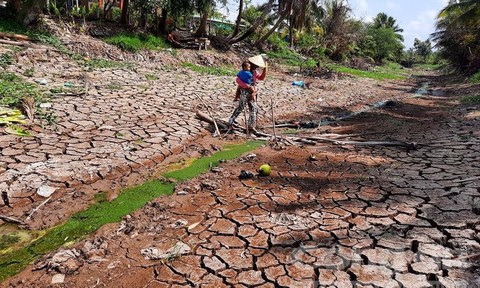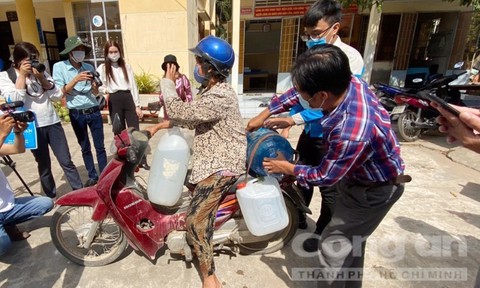In the next week, from 23-31/3, saline intrusion in Mekong Delta tends to increase slightly, then decrease gradually. Particularly salinity in some stations such as Long An, Ca Mau remained high, approximately or higher than last week.
In this context, the meteorological agency recommends that localities in the Mekong Delta should take advantage of fresh water storage as soon as possible at low tide; when watering the fruit trees, it is necessary to closely check the salinity to avoid damage.
Need to take advantage of fresh water storage
According to forecasts of the National Center for Hydrometeorological Forecasting, in the coming week, the Southern region will continue to maintain the status of low rain and sunny days. The Eastsouth provinces have a large area with the common temperature of 35-37 degrees Celsius. In the Southwest region, the temperature is commonly from 32-34 degrees Celsius, there are places where the heat is high. Afternoon humidity drops quite low, ranging from 45-55%. In the next 10 days, the water level in the upper Mekong will change slowly and lower than the same period in 2016 from 0.1-0.5m. Therefore, the water level on the Tien and Hau rivers also changes slowly with the tide; in which the highest water level in Tan Chau is 1.20m; at Chau Doc 1.35m, equivalent to the same period in 2016.

A canal in the Mekong Delta is dry due to drought and saltwater intrusion
With the above situations, the meteorological agency
forecasts saline intrusion in the Mekong Delta tends to increase slightly until
March 26, then decrease gradually. The highest salinity in this phase was lower
than the salinity in the period from 11-20 / 3, particularly the salinity of
some stations of Long An and Ca Mau remained high, approximately or higher than
last week.
The salinity boundary depth of 1g / l during this
period is likely to be as follows: Vam Co Dong River, Vam Co Tay River have
salinity intrusion range from 100-135km; Cua Tieu and Cua Dai rivers, with a
salinity range of 65-70km; Co Chien river, saline intrusion range 60-75km;
saline intrusion range of Hau River is from 55-65km; Cai Lon river 58-63km.
The salinity depth of 4g / l in this period at Vam Co
Dong and Vam Co Tay rivers has the saline intrusion range of 85-110km; saline
water intrusion range on Cua Tieu and Cua Dai rivers is 52-60 km; Co Chien and
Hau rivers 45-55km; Cai Lon river 43-52km. The level of disaster risk due to
saline intrusion in the Mekong Delta during this period is forecasted at level
1-2. Regarding the trend of water resources and saline intrusion in the dry
season in 2020, the National Center for Hydrometeorological Forecasting said
that from now until May 2020, the flow from the upper Mekong River to the
Mekong Delta is at 5-20% lower than the average for many years.
According to forecasts of the National Center for Hydrometeorological
Forecast, although saline intrusion in the Mekong River mouth tends to
decrease, it is still high until the end of March 2020. On Vam Co (Long An) and
Cai Lon (Kien Giang) rivers, in the Ca Mau peninsula, the possibility of saline
intrusion will continue to remain high until the end of April and early May
2020. . "In extreme cases, prolonged periods of lack of rain and increased
use of water on tributaries and dam storage will make drought, saltwater
intrusion more prolonged and aggravated," said the meteorological
forecast. The Hydrometeorology Agency also noted that during the period of
April 26 to April 3, localities in the Mekong Delta should take advantage of
the fresh water storage as soon as possible at low tide, when irrigating crops
and fruit, they should be checked closely for salinity to avoid damage.

People in the Mekong Delta are trying to save fresh water
Looking back at the recent drought and saltwater intrusion, the meteorological agency assessed that if the 2016 saline water intrusion was considered a record salinity, the 2020 dry season would have broken all established records.
Further information, Deputy Director General of the General Department of Meteorology and Hydrology Mr. Hoang Duc Cuong said that the situation of drought and saltwater intrusion in the Mekong Delta had signs starting from the middle of summer 2019. By the end of the year 2019, the risk of drought, water shortage, saline intrusion is more obvious.
On that basis, from the end of 2019, the National Hydrometeorological Forecast Center, Southern Hydrometeorology Station in Ho Chi Minh City and provinces in the Mekong River Delta have been determined. Once every 2 weeks, there are news and forecast reports on droughts and intrusions in the Mekong Delta.
The newsletters are updated if followed daily irregularities for the region's provinces. It is very important information for changing crop structure, adjusting supply, use of water sources; as well as strengthening measures to exploit and store fresh water before the flood season in order to reduce the damages.
Especially, with the timely guidance of the Prime Minister Nguyen Xuan Phuc and the proactive prevention of drought and saline intrusion in the localities, plant structure conversion especially the early winter-spring transplantation, up to 93% of the winter-spring rice area in the Mekong Delta successfully avoided drought.
With the above results, it is initially shown that this is also a victory in the fight against drought and saltwater intrusion in the Mekong Delta.
However, the situation of saline intrusion in some provinces such as Ca Mau, Bac Lieu, Ben Tre, Vinh Long, Tien Giang, ... is still complicated. Therefore, the fight against drought needs to be determined by localities in a spirit like quenching the COVID-19 epidemic.
Before the drought and saltwater intrusion, at a meeting with units under the Ministry of Natural Resources and Environment on water resources took place recently, Deputy Minister Le Cong Thanh proposed the Department of Water Resources Management through the Department of Natural Resources and Environment capture the thrilling area about the water situation of the whole Mekong Delta. On that basis, the Department of Water Resources Management in collaboration with the National Center for Water Resources Planning and Investigation discusses which results can be used immediately to propose a review of how to do so. “Scientists have assessed that salinity drought will occur more often. Therefore, the Institute of Meteorology, Hydrology and Climate Change makes a report on changes in the frequency of saline drought in the Mekong Delta from now to 2030. From there, the Ministry of Natural Resources and Environment will introduce issuing recommendations to the Government about water storage in this area, ”Mr. Thanh emphasized.